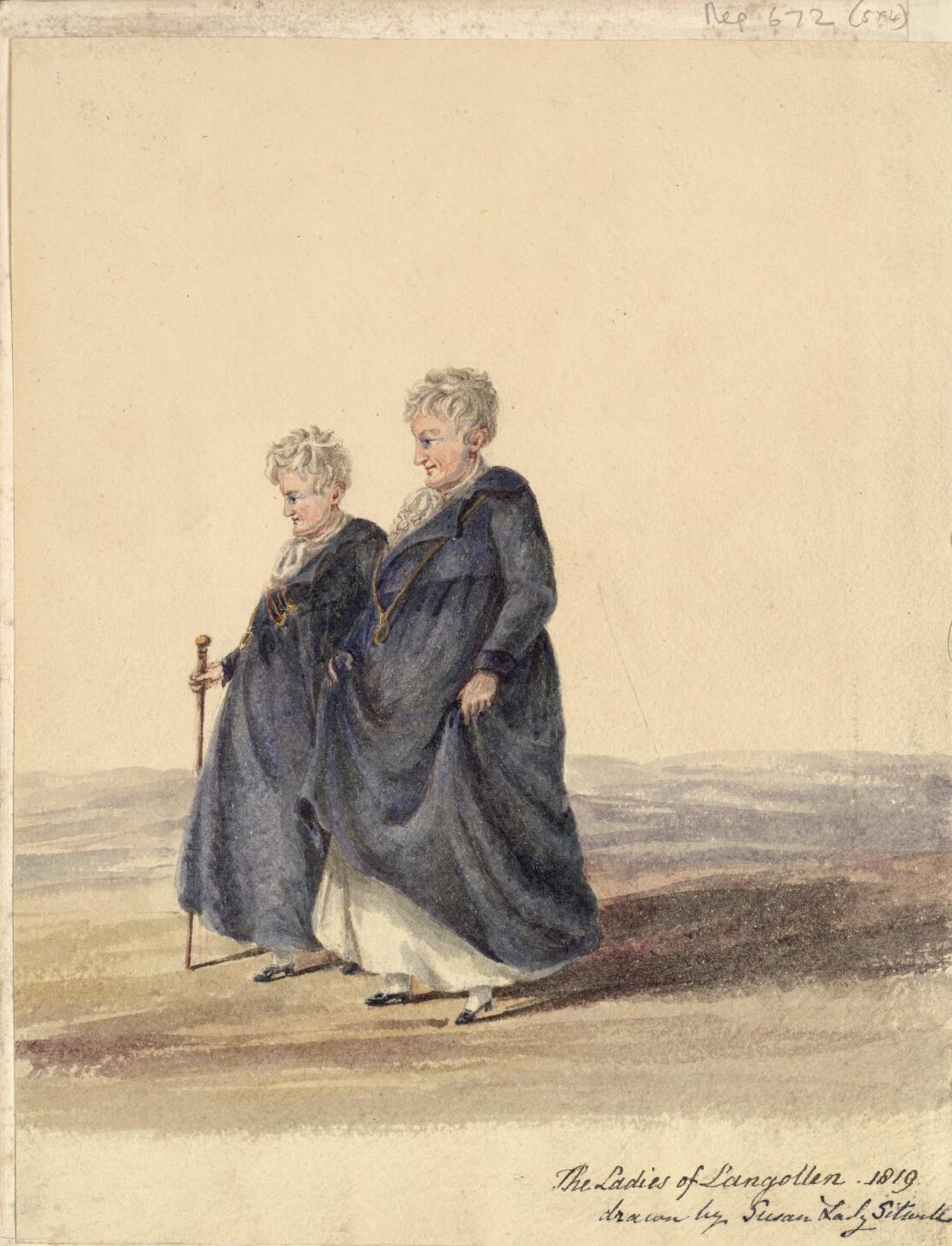When Eleanor Butler (1739-1829) and Sarah Ponsonby (1755-1831) landed in Milford Haven from Waterford in Ireland in May 1778 they were in search of a new life together. After travelling up through Wales, they settled on Pen-y-Maes cottage, which they later renamed Plas Newydd, in Llangollen. They never returned to their homeland. Over the next fifty years, the two women would become famous for their partnership and their house, and increasingly closely identified with the small town in which they lived.
Bound by close friendship since soon after they first met in the late 1760s, Butler and Ponsonby (fig. 1) had previously tried to leave Ireland together in March 1778. On that occasion, their families had stopped them at Waterford, and insisted that they return home. Both women were deeply unhappy – Butler was under pressure to enter a French convent, while Ponsonby (long an orphan) was enduring the unwanted sexual interest of her guardian. Finally persuading their families that they would not give each other up, Butler and Ponsonby left for Wales some six weeks after their first attempt, accompanied by the maid, Mary Carryl, who would live with them in Llangollen until her death in 1809.

The two women recorded their first few weeks in Wales in a tour journal. Their initial impressions read like standard touristic practice for the period: Ponsonby notes reading churchyard inscriptions in Hubberston on Monday 11 May, and taking the ferry to Pembroke on Tuesday 12 May, where they visited the ruin of Pembroke Castle (f. 2r). In the following days they visited nearby Carew Castle, commenting on the effigies in the church, before moving on to Carmarthen, which receives the following verdict in their journal: ‘[it] is esteem’d the principal City of Wales but did not answer our expectations’ (f. 3r) – an independently-minded spirit can be felt from the beginning of Butler and Ponsonby’s Welsh experience.
As Fiona Brideoake has recently pointed out, their observations tend to be ‘located within the discursive tradition of genteel domestic tourism’, celebrating picturesque landscapes and country houses, aestheticised ruins, decorative detail and Gothic architecture.1 This approach to travel is highly significant for the life that Butler and Ponsonby would go on to create in Wales, not least their refashioning of Plas Newydd (fig. 2) into a cottage ornée.2 But it is also evident in the material object of the 1778 tour, which is embellished throughout with Gothic script and baroque flourishes. The fair copy manuscript’s dramatic visual appearance adds a sense of authority to this account of a flight from troubled circumstances; more prosaically it also functions as part of its meaning, as Butler and Ponsonby frequently deploy handwritten typography as, or instead of, other punctuation.

The two women first reached Llangollen on the 25th May, though they appear not to have settled there permanently until 1780 when they leased Pen-y-Maes. The letters and diaries they wrote over the next half a century document their sociable, political and literary lives in North Wales. Reading, walking, gardening, farming and writing came to shape their time and locate them in their surroundings; they developed deep links with the landscapes and communities in and around Llangollen, and their network included shopkeepers, local poets and tradespeople, as well as gentry friends and acquaintances such as Thomas Pennant and Hester Piozzi.
However, this body of writing also shows how Butler and Ponsonby stood out, becoming not just part of the local landscape but an exceptional point within it. A life that began with a tour became in time a point on the tour: Plas Newydd, just off the main route between London and Ireland, was where they met curious strangers and passing friends and family. Some of their more famous visitors included Madame de Genlis, Anna Seward and William Wordsworth, who all later wrote in praise of Plas Newydd. Various manuscript tours in this edition (see, for example, Sophia Hoare in 1808 or Anne Lister in 1822) present alternative and less familiar perspectives on two women whose domestic arrangements were, and still are, the subject of considerable public interest.
Note on the source text:
The source text for this edition is a beautifully produced manuscript fair copy either in the hand of Eleanor Butler or Sarah Ponsonby. As noted above, the source text sometimes substitutes typography for formal punctuation. Unable to reproduce exactly the typographical features of the manuscript original, this edition includes formal punctuation where the transcription may otherwise be difficult to follow.
Notes
1 Fiona Brideoake, The Ladies of Llangollen: Desire, Indeterminacy, and the
Legacies of Criticism (Lewisburg: Bucknell University Press, 2017), pp. xxix, 72.
2 For an account of Plas Newydd as a cottage ornée, see Nicole Reynold,
‘Cottage Industry: The Ladies of Llangollen and the Symbolic Capital of the Cottage Ornée’,
The Eighteenth Century: Theory and Interpretation, 51: 1-2 (2010), pp, 211-27.
Further reading:
- Fiona Brideoake, The Ladies of Llangollen: Desire, Indeterminacy, and the Legacies of Criticism (Lewisburg: Bucknell University Press, 2017)
- Elizabeth Mavor, The Ladies of Llangollen: A Study in Romantic Friendship (London: Michael Joseph, 1971)
- ––– ‘Butler, Lady (Charlotte) Eleanor (1739–1829)’ and Ponsonby, Sarah (1755–1831), Dictionary of National Biography (Oxford University Press)